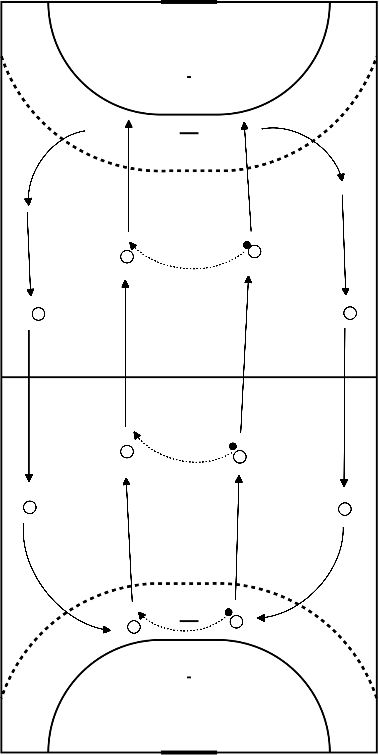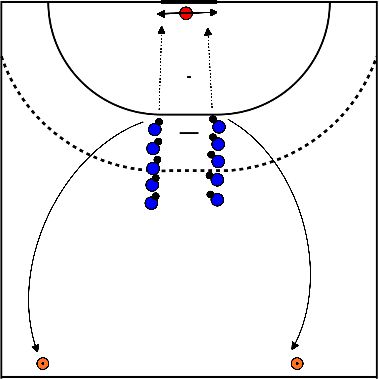Handball drills for technique warming-up
Make 2 teams and give 1 team vests.
Play with a good bouncing ball (hard handball/ goalcha ball/ beach handball/ tennis ball/ volleyball etc.)
Rules:
Play with a good bouncing ball (hard handball/ goalcha ball/ beach handball/ tennis ball/ volleyball etc.)
Rules:
- You may only touch the ball with your body (arms/legs/feet/head) 2x in a row. After that you may not touch it again until another player has touched the ball.
- You may therefore both play football and hit the ball
- If you touch the ball a 3rd time, the ball is for the opponent (free ball)
Goal:
- Try to score on 1 of the goals
- Scored? Ball for the opponent
Extension/variation:
- Play 2 or 3 balls at the same time (depending on the size of the group)
- Link rules to the different balls
- Example: football only heading, handball only playing with your foot etc.
- Link rules to the different balls
- Vary the places where the goals are placed (mat/duck out/advertising board).
- Vary the number of places where goals can be scored
- Keeping arms forward
- Small rotation with clenched fist
- Do not overextend
- Small rotation with clenched fist
- Jog quietly across the field
- Arms forward
- Backwards
- Turn against each other
- Arms crossed wide in front of the chest
- Alternating between up and down
- Arms wide and turn small circles
Question, which muscles do you feel when?
Relay
- 2 Groups stand in a row next to each other
- Starting point and ending point are marked with a pawn
- The player in front of the group rolls the ball backwards between all legs.
- All players where the ball has passed, lie down as quickly as possible
- The player in the back jumps over the players, connects and rolls the ball backwards again
- Important: Every player who has jumped over gets up again
The first group to cross the line wins.
Mats lie in a circle
- Walk around the mats, perform the task
- Walk to the middle and jump up
- Do a somersault on the mat Jump over the next mat
- Jumping from mat to mat
- Skipping from mat to mat
- Keeping arms forward, small rotation with hands, not extreme stretching.
- Slowly jog across the field, arms forward, backward, twisting against each other
- Arms crossed in front of the chest, alternating up and down
- Arms wide and turn small circles
Question: which muscles do you feel when?
- Put everyone in a circle with the ball in their hand and hold it high above their shoulder.
- They start with dribbling on the spot in high speed, after 30 seconds you do another exercise.
- Skipping (2 times on 1 leg then on the other leg)
- Jumping forward (2 legs at the same time) and back again
- Stepping to the left and to the right
- Shuffle forwards and backwards
- High speed dribble
- If this is too easy, extend the exercise by 45 seconds or 1 minute
- You make 2 teams
- 1 team starts with the ball and tries to tap the other team with the ball.
- They have to pass and are not allowed to run
- The other team tries to intercept the ball
- When the ball is intercepted, they can continue playing immediately
- If you tap someone you get 1 point
Who has the most points at the end?
- All players run through each other in a smaller field (10x10).
- They run the ball at speed, which they do for about 2 minutes
- Afterwards they do an exercise after they played
- Lie flat on their stomach and get up again
- Squat 2 times
- 2 times jumping jacks
You indicate which exercise they should do
Relay
- 2 Groups line up next to each other
- The player in front rolls the ball backwards between all legs.
- The last player slaloms around the players to the front, joins in and rolls the ball backwards again.
Variation
- Players lie down after rolling the ball backwards.
- The player in the back takes the ball and jumps over the other players
- Each player who has jumped over gets up again
The first group to cross the line wins.
- You place 4 pawns in a square approx 6x6m.
- Players are divided at the pawns, possibly in a row.
- One player gets the ball, walks slowly to the next pawn and throws the ball to the first player at the next pawn who has also started walking.
- As soon as the ball is caught, the first player at the next pawn starts walking and catches the ball again, etc.
- Important, players do not walk sideways but forwards and bend their upper body sideways.
- Make sure the players throw the ball into the hands of the next player.
- The higher the speed of the exercise, the further in front of the player the ball must be thrown.
- The exercise can be performed at all speeds, walking and running.
- You make pairs.
- Both persons stand on the circle at the same height as the poles.
- You run with 1 ball per pair to the other side of the circle.
- While running to the other side you throw the ball to each other.
- When you're on the other side you run back to the other side.
- Variation:
- Overhand throw.
- Knee-down passing.
- Passes with jump shot.
- Sideways jump to the opposite circle.
- Cross pass to the opposite circle.
- Accelerated pass. (50, 60, 70, 80 %)
- Sprint.

- The field players make 2 rows at the height of the posts.
- The balls are shot at the goal at the pace of the goalkeepers.
- Left high, right high, left high etc.
- However, when the players have taken a shot they do not calmly take the ball but sprint to the half way line.
- Variation:
- Another point can also be indicated by means of a
- pawn
- hat
- pole etc.
- Instead of the middle line.
- It is also possible to make another movement instead of sprinting.
- For example the side jump.









